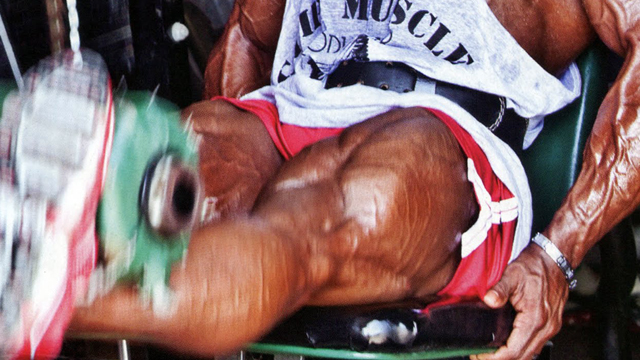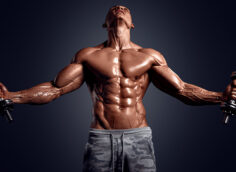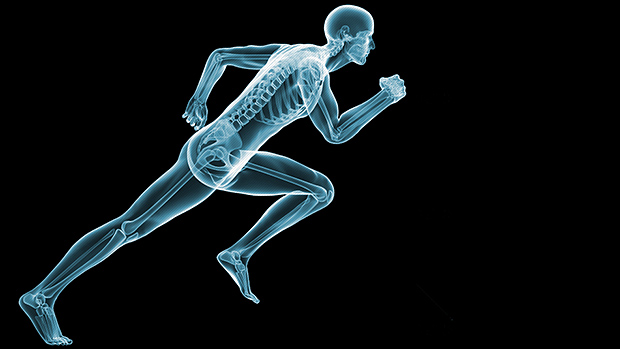T-mag listens to its readers. When we get a lot of feedback about a particular article or a contributor, we pay attention. After Christian Thibaudeau published a few articles with us, the message we received from readers was pretty clear: "We want to hear more from that guy!"
Thibaudeau (pronounced Tee-Bow-Doh) is yet another French Canadian phenom in the strength and conditioning community. He's successfully trained a wide array of athletes from Olympic lifters and strongmen to hockey players and figure skaters. He's also a competitive Olympic weightlifter, a football coach, and is completing his M.Sc. degree in exercise science. Judging from his articles so far at T-mag, he also knows a heck of a lot about packing on mass.
We decided to sit down with Thibaudeau and pick his brain about a variety of topics.
Testosterone: Let's start off with some personal history. What's your athletic background and how did that lead to you becoming a coach yourself?
Christian Thibaudeau: I was the kid that nobody ever selected for dodgeball in grade school. You know the type: skinny-fat with no athletic ability, much less physical capacities. The sad thing is that I loved sports. I watched every type of sport there was on TV, day in and day out. I loved athletics so much but was about the worst athlete in the world!
T: I've seen you lift and obviously a lot has changed! What happened?
CT: When I turned 11, I decided that enough was enough. I actually started doing push-ups, sit-ups and other such exercises every day. While it didn't turn me into a future Olympian, it did improve my self-esteem somewhat. From that moment on I was hooked on training!
In high school I was able to make the football team as a receiver. That's when I really started working out hard. I was about 13 years old and would train every lunch hour. When I look back I must say that I started my training career doing exactly the opposite of what all the others did. Most guys start off training only their upper body; I only worked my legs. I reasoned that as a receiver I only needed strong legs.
By the time I turned 17 I was a trainaholic! I was playing linebacker and trained every chance I had. In the morning I'd do biceps curls to look good at school (yeah, I've been that guy!), at lunchtime I'd train my legs, and in the evening I'd work my upper body. The sad thing is that I was addicted to working out, but knew nothing of nutrition. As a result I only gained a little mass and ended my high school career at 5'9" and 175 pounds.
In college I really started to train intelligently. Our team had a very good strength coach (whom I'm now working with) and my weight went up to 225 pounds in two years, and I had strength to match, at least for a 19-year-old kid.
Basically I never had talent at any sport; that's what prompted my interest in training. Ironically, there wasn't a day in which I wouldn't curse my lack of talent. Today I actually think of it as a blessing in disguise. I realized that I liked training more than playing football. So after my "career" was over I turned to Olympic lifting. I also competed in strongmen competitions. I did fairly well, but at 5'9" it's hard to be competitive.
T: What do you do now as a coach? What's your week like?
CT: My schedule varies during the year. In the summer I spend five to eight hours a day training hockey players; that's their off-season. During the season most leave for their respective team. We keep in touch but I don't train them directly. I also train football players in my group. On some days I have 15 to 20 athletes training together. That makes for a very positive and motivating atmosphere. In the winter my clientele is mostly comprised of football players and figure skaters.
I'm also a football coach and that takes up a lot of my time, but I just love working with young athletes. As I said, I always loved athletes and I consider any chance I get to work with them a blessing, regardless of their level.

T: Judging from your training photos, I'm guessing you're now one strong and powerful S.O.B.! What are your best lifts?
CT: Well, I've got what I'd call good overall strength; I'm not extremely strong in a few lifts. I can't compete with elite powerlifters as far as the deadlift, squat, and bench press are concerned and I started Olympic lifting too late to be an international force, but I have no weakness.
I've cleaned 170kg (374lbs) from blocks, power cleaned 145kg (319lbs) from the hang for four reps, clean and jerked 162.5kg (357lbs), snatched 132.5kg (291lbs) with straps, power snatched 120kg (264lbs), full squatted 255kg (561lbs) with no suit or wraps, front squatted 200kg (440lbs). I don't train the bench press more than three months or so out of the year but I've done 180kg (395lbs). I've also push pressed 150kg (330lbs).
Nothing to write home about, but it does show some strength balance. And I feel it's not that bad for the worst genetics on the planet!
T: Well, you may not be an "international force," but that's pretty damn impressive to most people! Switching gears, you once wrote that aerobic conditioning was overrated for boxers. What about everyone else?
CT: It's overrated for everybody but distance athletes. My athletes never do any aerobic work. However, they'll do a lot of 50 to 60 seconds sprints while pulling a light sled, lots of 400m running with short rest intervals and lots of HIIT type running.
I feel these training methods are much more sport specific and more effective at burning body fat. You should see the body of hockey player Alex Tremblay, the leading scorer in Canadian University Hockey. Most natural bodybuilding competitors look like Fat Albert next to him!
T: You've also written about something called non-functional hypertrophy. Tell us about that.
CT: I'm not the first to talk about non-functional hypertrophy. Dr. Mel C. Siff is probably one of the first to have explained this concept. More recently Brian Haycock has also brushed the subject.
Basically, non-functional hypertrophy refers to gains in muscle size that aren't associated with an improved capacity to produce force. That could either be due to hypertrophy of the non-contractile elements of the muscle structure (sarcoplasm, collagen, etc.) or an increase in fiber size that's excessive and leads to internal friction which reduces concentric force potential.
T: And in English that would mean.....
CT: Non-functional hypertrophy is like adding weight to your car without touching the engine. Your car is heavier but you don't have more power to balance that increase in weight. It might make you look good, but it certainly won't make you efficient! It's the classic case of looking like Tarzan but playing like Jane.
Athletes should focus on functional hypertrophy. To promote it you must use methods which lead to a high level of muscular tension. We're talking about heavy-load training and explosive training. The two best examples of functional hypertrophy are the Westside Barbell Club lifters and elite Olympic weightlifters.
T: Cool. We see a lot of stuff these days encouraging bodybuilders to incorporate Olympic lifts into their training. Why should a bodybuilder – or just some guy wanting to look big and powerful – use Olympic lifting?
CT: Because I said so! Nah, seriously I think it all comes down to a variety of stimulus. Bodybuilders pretty much have the slow, controlled exercises covered. They use mostly moderate tension/long TUT methods which are good to some extent, but I've always believed if you attack an enemy via several fronts you stand a greater chance of winning. Same thing goes with training!
Explosive training, not just the Olympic lifts, creates a very brief but extremely high intramuscular tension. This is a powerful growth stimulus that shouldn't be forgotten. F = ma [Force equals mass times acceleration]. By using high-acceleration exercises you increase force output, which increases intramuscular tension, which increases growth stimulus.
But in all fairness, bodybuilders don't have to use the Olympic lifts. Including regular lifts that are performed explosively is a good start.
T: Can you give us an example?
CT: The Westside guys use the bench press and squat because these are their main competition lifts, but an athlete or bodybuilder could use the same method with other exercises. I'd recommend using only multi-joint exercises for that purpose, though.
I'd say that the Olympic lifts are superior to develop whole-body power, but for some guys who don't have access to an Olympic lifting coach, this last option can be a viable choice.
T: Okay, this may sound crazy, but speaking of lifting explosively, I read something once about actually throwing the bar up out of your hands while benching, then catching it. Is that a real training technique or just a flamboyant way of committing suicide?
CT: Funny you should mention that! I've seen a form of bar throwing drill performed by many athletes. In fact, Alexeyev himself used what he called "snatch throws" in which he'd throw the bar for height, kinda like strongmen and highland game athletes who throw objects for height.
I've also seen Adam Archuletta perform bench press throws, but he was using a contraption similar to a Smith machine. I hate the Smith machine, but I believe this is one instance in which it might actually be useful. I've used this drill myself. I equate it to a jump squat for the upper body and thus recommend using 20 to 30% of your max bench press.
T: Very interesting! In fact, I think TC wrote about using the Smith machine this way back in the early days of T-mag. I think he called them "Katzenjammers." Anyhow, let's change subjects. What's your general opinion of steroids?
CT: That's hard to answer in my position, given that I still compete in a tested sport and that I work with a lot of young athletes, but I feel that they're not as bad as most people think they are. I'd certainly not give them to my athletes, but I know that for 90% of the athletes out there, steroids are necessary to reach the top. In some sports, you just can't win without them. Sad but true.
I do feel that with proper supplementation and nutrition you can approach the effects of steroids, at least as far as strength and power are concerned. I hate to make generalizations, but an optimal supplementation stack could give most people 50% of the results of a steroid cycle. I know it sounds corny, but I've seen it work! I've had numerous athletes gain 20 pounds of muscle and 10 to 15% on all major lifts in three months from hard training and an optimal supplementation regimen.
However, for athletes who decide to use steroids, I feel that a short cycle approach is optimal. Obviously for bodybuilders it's another story.
T: Any supplements you consider essential?
CT: Well, it depends on the needs (and budget) of the athlete. But if it's going to give you an idea, my own supplement cabinet contains flax seed oil in industrial quantities, Tribex-500, M, protein digestive enzymes, Grow!, multivitamins, ZMA, and Power Drive. I'm also evaluating Myostat and I use creatine, but only intermittently. I believe this is a great list for any athlete. Depending on the goals I might add a few things.
T: When it comes to professional athletes, I'm sometimes astounded about how little they know about diet and training. They seem to be great despite their level of knowledge. Is this a testament to superior genes, great coaches, or what?
CT: A year ago I would've said superior genes, but now I think that superior motor control is the reason. The greatest athletes are motor geniuses. Motor control is somewhat predetermined, but motor potential can be greatly improved during childhood. In my opinion, that's the period during which elite athletes are made.
One of the greatest mistakes made by parents is early specialization. Here in Canada parents will decide to turn their son into the next Mario Lemieux when he's five years old! From then on he'll only practice hockey. Big mistake! I believe that during childhood it's important to develop all motor abilities and that requires a wide array of stimulations. A child should participate in many different activities. For one, I believe that gymnastics are a great sport introduction for most kids.
T: Let's get to the ugly stuff. What things or people in your field drive you crazy and really piss you off?
CT: There are two things that drive me nuts. First are the sport coaches. In most sports there's a certain "training tradition," e.g. hockey players must do a lot of aerobic work, figure skaters can't do strength training or they'll get too big, etc. When you come up with novel training approaches these coaches are often skeptical and some are downright against what you're doing. That complicates your job because in the end, they hold the big end of the stick.
The other thing that drives me nuts is the constant need to "sell." You gotta' be more innovative than the others, sound better, be bigger than life. The thing is, pretty much everything has been done! At least everything that's really effective. But many coaches – who are trying to look better then they are – always come up with new stuff only for novelty's sake. Innovation is good, but not at the expense of efficiency.
T: You once wrote, "Complexity is the language of simple minds. Always be wary of the guy who sounds impressive." Was that a jab at some people in the coaching field?
CT: You better believe it! I feel there are many coaches out there who try to make their mark by sounding intelligent and spouting complex words and concepts. I won't point any fingers but they're generally the people who, deep down, lack confidence. These people are also known for clinging to other better known coaches to help their own progression and to multiply personal attacks on other coaches.
T: Not surprising in this crazy industry! Now, I like to use the term "missing ingredient" a lot. What missing ingredients do you see in athletes and bodybuilders? In other words, what are they overlooking that could really help them?
CT: If you read my T-mag hamstring article you'll have the answer: they need better hamstrings! Most athletes will benefit immediately from additional hamstring work.
I also believe that most athletes don't use supplements wisely. I've only seen two approaches that athletes take in regard to supplementation: They either ignore it or they shotgun it! Those who use supplements don't know what they're taking or why they're taking them half the time. Plus, too many of them "overtake" supplements. Balance and timing is more important than sheer quantity.
T: Agreed. Just for the fun of it, give me an exercise that you feel all weight-trained athletes should be using, yet most don't.
CT: For athletes I'd say the power snatch from blocks. For regular individuals and bodybuilders, I'd go with snatch grip deadlift and push press.
T: What's the most useless, worst exercise out there that people put in their programs?
CT: There aren't really any "bad" exercises. Any exercise is better than doing nothing. But there are some that aren't much better than doing nothing! I personally don't think too highly of any sentence that ends, "on the Smith Machine.

T: As an Olympic lifter, what do you think of the squat?
CT: Obviously, I do believe that the squat is the best exercise to develop lower-body strength. Nothing beats it. However, I feel that neglecting the hamstrings while building a big squat is a surefire way of getting injured. All exercises are good, but there's such a thing as too much of a good thing.
The one thing that sickens me about the squat is that it's been turned into a macho lift. The guy will load up the plates, grunt, shout, and do one-eigth of a rep! I feel that when it comes to the squat, the most important thing is to use proper form and a full range of motion; only add weight if you can handle a full repetition!
T: How about the leg press? We hear a lot of mixed opinions on it from various coaches.
CT: I rarely use the leg press in my athletes' training. The only case in which I've used it was an athlete who had shoulder problem and couldn't even put the bar on his shoulders – the stretch was too much! While I worked on rehabbing his shoulders I had him train on the leg press and hack squat.
I also believe the leg press can be a viable third leg exercise, behind squats and lunges in a program. I don't see the leg press as a main exercise. When performed well, it's not more dangerous than any other exercise, but it's just not that effective.
T: You train combat athletes, lifters, and strongmen but you also train figure skaters. That's a little shocking. What do you do with them exactly?
CT: [laughing] Well, I'm not going to tell you what I'd like to do with some of them for sure!
T: Mmm, Michelle Kwan wearing nothing but whipped cream.... Oh sorry, go ahead.
CT: Three years ago a friend of mine named Martin Gervais came to me for help. He was intelligent enough to recognize the value of the Olympic lifts for skaters. At first I was brought in to teach them the Olympic lifts and eventually I began training them full time. Soon we added two other elite skating clubs to our list.
T: How did they do?
CT: I'll tell you, do not underestimate these girls! They might look like little ice princesses but in the gym they mean business. I even had one skater compete in Olympic lifting where she won three bronze medals at the Quebec Games (equivalent of a tri-state championship). At 14 years of age and a bodyweight of 128 pounds, she power cleaned and jerked 60kg (135lbs) and power snatched 50kg (110lbs). In training she even did a set of five reps with 45kg (100lbs) on the power snatch after less than three months of training!
It's a lot of fun working with the skaters. Once you get past the cute little dresses, they're like any other athletes.
T: It seems that every type of athlete is weight training these days. I mean, in the old days, golfers didn't lift weights, they just golfed. Now the best of them use resistance training. I also read about NASCAR drivers hitting the weights. Your thoughts?
CT: I feel that every activity that requires some form of physical capacity can be improved with strength training. It's just a matter of finding the proper exercises.
Funny you mention NASCAR drivers. I worked with a Panoz series pilot all summer long. The training included a lot of "weird" exercises but also some basic stuff like power cleans and other such movements. We also did a lot of neck and abdominal work.
T: What about the mental or psychological side of training? Got any interesting tricks or tidbits of info there we can apply to our workouts?
CT: I must confess that both my parents where psychologists. In fact, my father once worked as a sports psychologist. But in all honesty I don't feel that special psychological techniques need to be used. The most important thing is for the athlete to have an optimal level of arousal.
Too little arousal and the intensity will suffer; too much arousal and you might actually burn out by "over-psyching" yourself. I see lifters banging their heads and shouting before a hard lift. That's no good! It might help in the short term, but in the long run it might actually be detrimental. I much prefer a focused and confident approach.
So I'm not a big fan of the ephedrine and caffeine stack as I believe it can cause over-psyching. However, I do believe that Power Drive can help get you into that focused zone.
T: When discussing overtraining with the world's best coaches, I've noticed that some of them take it very seriously. It's their number-one priority to prevent it. Yet others think overtraining is overrated, and that people pay way too much attention to it. What do you think?
CT: I take overtraining seriously. In fact, I've sent some of my athletes home after only one exercise because I felt they were out of gas. No matter how good your training plan is, you must always monitor how your athlete is feeling. You never know what could lead to overtraining: a stressful job, a tough relationship, you name it.
I find that taking the morning heart rate is a good indicator of the physical state of the athlete. If the morning heart rate is 3-5 BPM (beats per minute) higher than normal, you might want to cut down the volume slightly. If it's 5-10 BPM higher than normal, both intensity and volume must be decreased.
T: Good tip! Do you think there's ever going to be a "next big thing" when it comes to weight training, or have we pretty much figured it all out already? Is there any training system out there now that you'd call the "next big thing" or is it just more novelty stuff designed to "sell"?
CT: Mostly it's designed to sell. And the sad thing is that today's novel approaches are actually quite old! They just have been forgotten and rediscovered.
There are some things that show promise, like vibration training for example, but I wouldn't call that the "next big thing." In my opinion, the next biggest breakthrough will come from a refining of the current training methods. We have all the tools, but I just don't think we know exactly how to use them yet. I also believe we'll see some novel methods, but these will mostly be derivations of what we have right now.
The problem is that we might very well have a "next big thing" and never realize it. See, there's so much bull out there, so many fads, that it's likely that the "next big thing" will be introduced much like those fads and we may miss the boat. But I'll keep my eyes open and keep you informed!
T: Let's back up just a second. What's vibration training?
CT: Vibration training has been developed by Carmelo Bosco, an Italian sport scientist better known for his work on power output and vertical-jump testing. This relatively new method consists of standing on a special platform than can vibrate at different rhythms and amplitudes. This intense vibration has been shown to improve power output, jumping height, and strength.
Furthermore, one could do stretching exercises while on the platform to greatly enhance the effect of the stretch. Vibration training does seem to have an overall effect on the whole body. It also affects growth hormone release and leads to a very intense CNS activation. The training stimulus with vibration training is very intense because the stimulus changes so fast. This creates a great need for muscle activation. For those who'd like to learn more, visit Power-Plate.com.
T: Thanks for the chat, Christian. We look forward to seeing more articles from you in the future at T-Nation.
CT: It's been a pleasure, Chris.




